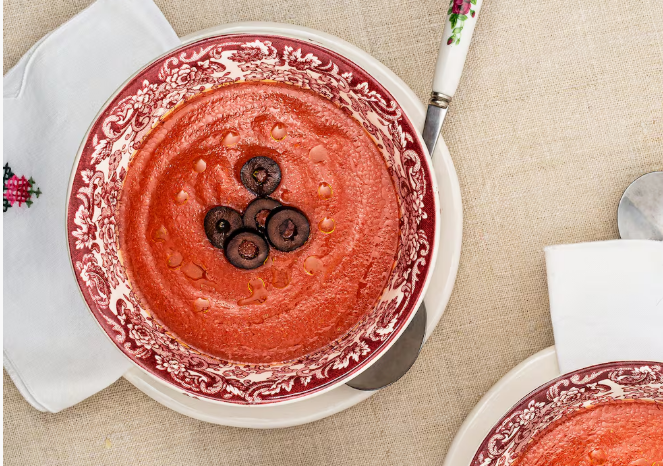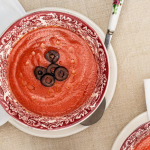Zoque Malagueño: The Andalusian Chilled Soup with a Carrot Twist
Spain’s Andalusian cuisine is a treasure trove of cold soups, from the world-famous gazpacho to the creamy salmorejo of Córdoba. Yet nestled within the culinary traditions of Málaga is a lesser-known gem: zoque malagueño, a vibrant red soup that stands out for its unusual inclusion of carrots. This refreshing dish offers a snapshot of southern Spain’s culinary ingenuity, born out of necessity and perfected over generations.
The name “zoque” is steeped in history, tracing its origins back to the Arabic word suqât, meaning “waste” or “something of little value.” This etymology reflects the humble beginnings of the dish, which was traditionally made with stale bread—a staple ingredient in many Spanish recipes. Rather than letting bread go to waste, Andalusians transformed it into hearty, nourishing soups that could feed entire families. Over time, tomatoes, peppers, olive oil, and other Mediterranean ingredients enriched the recipe, turning peasant food into a refreshing summer delicacy.
Interestingly, “zoque” also refers to another dish native to Benamargosa, a town in Málaga’s Axarquía region. This version revolves around limón cascarúo, a thick-skinned, mildly acidic lemon variety. In that preparation, lemons are peeled to expose as much of their white pith as possible, chopped into chunks, and marinated with a paste of bread, garlic, oil, vinegar, salt, and a dash of paprika. Water is added to create a tangy soup that highlights the lemon’s distinctive flavor. This citrusy interpretation is still sold during Málaga’s Holy Week as a traditional snack, a nod to its enduring cultural significance.
The red vegetable-based version of zoque, however, has gained wider popularity, especially in Málaga city. Its most striking feature is the inclusion of carrots, a rarity in Andalusian chilled soups. While gazpacho and salmorejo rely almost exclusively on tomatoes, peppers, and cucumbers, zoque introduces a subtle sweetness and earthy flavor through carrots, giving the soup greater complexity. Some food historians speculate that carrots were a modern addition, made possible by the advent of electric blenders and food processors. Before these appliances, Andalusians prepared these soups by painstakingly grinding ingredients with a mortar and pestle, a laborious process that would have made pureeing raw carrots nearly impossible.
The modern preparation of zoque malagueño is simple, quick, and accessible, making it a perfect summer recipe for home cooks. For four servings, you’ll need about 1.25 kilograms of ripe tomatoes, a small red bell pepper, two carrots, 100 grams of bread, vinegar, salt, and 100 grams of extra virgin olive oil. The process begins with washing and peeling the vegetables, then blending them with garlic until smooth. The bread is soaked in the vegetable juices, allowing it to soften and contribute to the soup’s creamy texture. After straining the mixture for a silky finish, vinegar and water are added to balance flavors, and olive oil is drizzled in slowly to create a luscious emulsion. Once seasoned to taste, the soup is chilled in the refrigerator, ready to be served cold with a variety of toppings such as diced ham, shrimp, or briny olives.
What makes zoque especially appealing is its versatility. It can be enjoyed as a light appetizer, a cooling lunch on a hot day, or even a vibrant starter for a dinner party. The addition of carrots not only enhances the flavor profile but also boosts the dish’s nutritional value, adding beta-carotene, vitamin A, and antioxidants to an already healthful recipe. Olive oil, a cornerstone of Andalusian cooking, lends richness and heart-healthy fats, while vinegar provides a bright, refreshing tang.
Zoque malagueño also carries a deep sense of place. Málaga, with its Mediterranean climate and agricultural abundance, has long been a hub of culinary exchange. The dish reflects centuries of cultural influences, from Moorish agricultural practices to Spanish traditions of bread-making and olive cultivation. The very fact that this soup elevates leftover bread into a gourmet delicacy speaks to a philosophy of sustainability deeply ingrained in Andalusian cooking.
Unlike gazpacho, which has become an international staple, zoque remains relatively unknown outside Spain. Its name rarely appears on restaurant menus beyond Andalusia, and even within Spain, it is often overshadowed by salmorejo. Yet for those who seek to explore regional Spanish cuisine, zoque offers a delicious introduction to Málaga’s culinary identity. Its bright color, smooth texture, and subtly sweet flavor profile set it apart from other cold soups, while its rustic origins tie it firmly to southern Spain’s history.
Visiting Málaga in summer is the perfect opportunity to taste zoque in its birthplace. Many local restaurants and tapas bars serve it with traditional accompaniments, often alongside fresh seafood and other Andalusian specialties. For a more authentic experience, some travelers venture inland to towns like Benamargosa to sample the lemon-based variant, which remains a point of pride for locals. Whether made with citrus or carrots, zoque embodies Andalusia’s culinary creativity and its ability to transform simple ingredients into something extraordinary.
For home cooks outside Spain, preparing zoque is a way to bring a taste of Málaga to your own kitchen. With just a handful of ingredients and about twenty minutes of preparation time, this soup delivers a burst of Mediterranean flavor that pairs beautifully with crusty bread, olives, or a chilled glass of Spanish sherry. Its simplicity is part of its charm: a recipe that has evolved over centuries but still relies on humble, fresh produce and pantry staples.
In an age of complex gastronomy, zoque malagueño is a reminder that culinary excellence often lies in simplicity. Whether you’re drawn to its historical roots, its vibrant flavors, or its nutritional benefits, this cold soup is well worth adding to your summer repertoire. Like gazpacho and salmorejo, zoque tells a story of resilience, resourcefulness, and cultural fusion—a story best savored spoonful by spoonful on a warm Andalusian afternoon.








